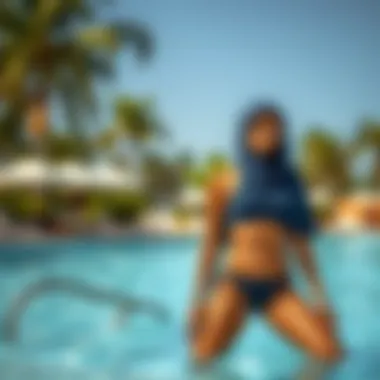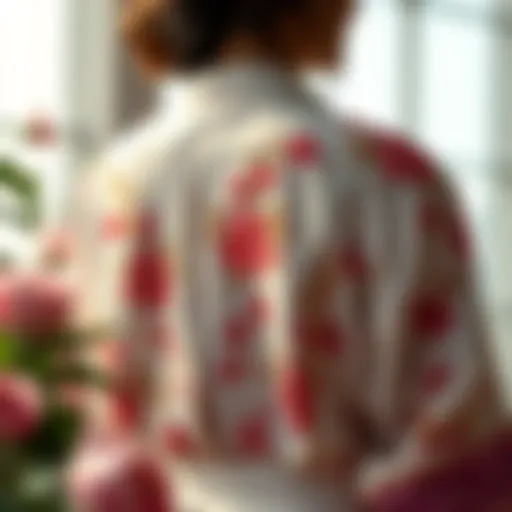Exploring Modest Wear Swimwear: A Comprehensive Guide


Intro
In recent years, modest wear swimwear has carved out its niche within the broader tapestry of fashion. It reflects not just personal style but also cultural significance and societal norms. As the tides of change sweep through the fashion industry, modest swimwear has evolved from basic designs to a vibrant assortment of styles that cater to a variety of tastes and preferences.
In this exploration, we will dissect various elements that define modest swimwear today. From the types of fabrics that make the designs comfortable and functional to style tips that elevate one's look, this guide seeks to paint a comprehensive picture. Whether you're seeking to combine fashion with ease of movement or considering sustainability in your swimwear choices, this article provides insights tailored for fashion enthusiasts, stylists, and retailers alike.
This guide will shed light on:
- The evolution of modest swimwear and its relevance in contemporary fashion
- Fabric choices and their impact on comfort and style
- Practical style tips, including how to pair outfits and current seasonal trends
Prepare to dive deep into the world of modest swimwear, where style and comfort converge!
Understanding Modest Wear Swimwear
In today's fashion landscape, modest swimwear occupies a niche that combines personal expression with cultural sensitivity. Understanding this concept opens various avenues—be it social acceptance, comfort, or even the awareness of sustainability in fashion. Why does modest wear matter? For one, it serves to empower individuals who choose to dress in a manner that aligns with their values, beliefs, and personal comfort levels. This section will dive deeper into the intricacies that define modest swimwear and why it's more than just a trend.
Definition and Historical Context
When we talk about modest wear, it's not merely about covering up. Historically, modest swimwear has roots that traverse cultures and eras, from the long, flowing garments of the Victorian era to the two-piece burkinis seen today. In many ways, these garments have evolved alongside shifting societal norms regarding body image and femininity.
The definition of modest swimwear can vary greatly, from garments that simply offer more coverage compared to traditional swimsuits to those specifically designed to adhere to ethical or religious standards. The term ‘modest’ can mean different things in different contexts—what is seen as modest in one culture might be completely different in another. Understanding this historical context allows wearers to appreciate their swimwear choices as part of a larger dialogue concerning body positivity and expression.
Cultural Impacts on Modest Swimwear
Culture, undoubtedly, plays a decisive role in shaping perceptions and acceptability of clothing, including modest swimwear. In many non-Western societies, swimwear that covers more of the body is considered not just appropriate but essential, reflecting deep-rooted customs and values. For example, in countries like Saudi Arabia or Indonesia, swimwear is designed to align with both local customs and modern needs, blending tradition with innovation.
"The fabrics may differ, but the sentiments are universal—swimwear should feel good, both inside and out."
Conversely, in Western cultures, the acceptance of modest swimwear is often limited by prevailing beauty standards, which can lead to a stigma surrounding fuller coverage options. Recent advancements in fashion technology and social media influence have started to reshape how modest swimwear is viewed, expanding its visibility and appeal among a broader audience. Many fashion influencers and modest fashion advocates are championing these designs, proving that modest can be both chic and contemporary.
Through examining cultural influences, we better understand how modest swimwear is not just about clothing choices but also about narratives and representations. It's about feeling comfortable in your skin while also honoring your beliefs. As global interconnectedness grows, so does the dialogue surrounding modest wear, making it a crucial discussion in today's fashion terraine.
The Evolution of Swimwear Styles
The evolution of swimwear has been a fascinating journey that mirrors broader societal changes, particularly regarding modesty and self-expression. In the context of modest wear, it’s essential to understand how these styles have transitioned over time, shaping what we see today. This section discusses the importance of recognizing these developments, underscoring how cultural shifts influence the design and functionality of swimwear, catering to diverse body types and personal styles.
Traditional Types of Modest Swimwear
When we look back at the history of swimwear, traditional modest designs predominantly featured longer hemlines and fuller coverage. In various cultures, garments such as the burkini, complete with a hijab, flourished, providing swimmers with a fashionable yet modest option.
Some classic examples include:
- The Swim Dress: This garment combines a dress-style top with attached shorts or swim leggings, creating a flattering silhouette while maintaining coverage. Typically, the design includes a flowing skirt that enhances comfort without compromising on style.
- Rash Guards: Originally designed for surfing, rash guards have now become popular among modest wearers. They provide UV protection and are often made from lightweight, breathable materials to ensure comfort during aquatic activities.
- Burkinis: This contemporary swimwear merges traditional coverage with modern fabrics designed for water sports. The burkini often covers the torso and legs and is paired with a headscarf, making it a popular choice among individuals prioritizing modesty without sacrificing comfort in swim settings.
These historical designs and garments illustrate a dedication to both functionality and respect for personal and cultural beliefs. Despite societal advancements towards individuality and body positivity, these traditional options remain valued by many today.
Contemporary Trends in Modest Swimwear
As cultures evolve, so too do fashions. In recent years, the modest swimwear landscape has seen innovative transformations. Embracing modern aesthetics while catering to modesty, many brands are blending comfort and style.
Some notable trends include:
- Athleisure Influence: The rise of athleisure has spilled over into swimwear, with many brands offering styles that are not only suitable for the water but for dry land as well. Incorporating features like quick-drying materials and stylish cuts, these swimsuits are designed for those who lead active lives.
- Pairing Swimwear with Activewear: It’s common now to find swim tops and bottoms that match activewear, providing versatility for activities beyond the beach or pool, encouraging a lifestyle of wellness and fitness.
- Sustainable Options: With an increasing awareness of environmental issues, many swimwear brands are focusing on eco-friendly materials. From fabrics made from recycled plastic to biodegradable options, today’s modest swimwear often reflects a commitment to sustainability, a trend that resonates deeply with environmentally conscious consumers.
In today’s market, styles that account for modesty are no longer just a niche; they represent a growing community craving fashion that aligns with their values.
The evolution from traditional to contemporary modest swimwear highlights a blend of cultural respect and modern innovation, paving the way for individuals to express personal style while adhering to their values. This dynamic landscape continues to inspire, making modest swimwear a vibrant area within fashion today.
Material Considerations for Modest Swimwear
Choosing materials for modest swimwear goes beyond mere aesthetics; it plays a pivotal role in how the apparel performs and feels during use. With a growing interest in sustainable fashion and a universal appeal for comfort, understanding the materials employed in swimwear can significantly dictate the overall experience for the wearer. The effective combination of durability, breathability, and environmental consciousness is now at the forefront of the modest swimwear conversation.


Common Fabrics Used
Polyester
Polyester is a powerhouse in the swimwear industry, offering durability and resistance to fading, which makes it ideal for swimsuits that see a mix of chlorine and salty waters. One characteristic that stands out is its quick-drying nature. This means no more soggy swimsuits clinging uncomfortably to your skin after a dip. The fabric wears exceptionally well against the skin, reducing the risk of irritation, which can be crucial for those looking for comfortable options.
However, there's a flip side. One major downside is that polyester can sometimes feel a bit stifling on hotter days, as it doesn’t breathe as freely as natural fabrics. But with advances in textile technology, many brands have developed polyester blends that tackle these concerns more effectively.
Spandex
Spandex, also known as elastane, is renowned for its exceptional elasticity. When incorporated into modest swimwear, it allows for a snug fit that can comfortably accommodate various body types while providing the necessary freedom of movement. This characteristic is more important than ever for those who wish to engage in water sports without worrying about their attire.
A key advantage of spandex is its ability to retain shape, even after multiple uses and washes. However, spandex's stretch does come at a cost. It is less resistant to UV rays compared to other materials, which might suggest potential fading over time when exposed to sunlight. Still, when blended judiciously with other fabrics, spandex contributes significantly to the overall feel of swimwear by enhancing comfort.
Recycled Materials
An increasing number of brands are turning their attention to recycled materials, reflecting a broader trend towards sustainability in fashion. These materials not only help in reducing waste but also bring about a sense of responsibility for consumers who are environmentally conscious. The fabrics derived from recycling plastic bottles and other sources maintain performance qualities similar to virgin polyester, making them a suitable option for swimwear.
One unique feature of recycled materials is that they often have a soft texture while still remaining strong and durable. Their increasing popularity signals a shift in consumer preferences, with more people willing to invest in products that reflect their values. However, a challenge remains; some consumers may view these materials with skepticism regarding their longevity and performance. Yet, numerous studies and quality assurance have shown they can stand toe-to-toe with traditional fabrics.
Breathability and Comfort
In the world of modest swimwear, breathability and comfort are not just preferences; they are essentials. The right material choice impacts how the fabric interacts with one's skin, and therefore, how enjoyable the swimming experience can be. A suit that traps heat or feels too tight can detract from the joy of being in the water.
Materials that allow for airflow help in regulating body temperature, particularly on hot days when one is likely to spend extended periods outdoors. Swimwear that keeps skin dry while allowing moisture to escape often becomes a favorite, especially for those who engage in more active pursuits. It’s not just about looking good but also about feeling good and confident in your choices when stepping into the surf.
"The materials you choose can turn the tide on your swimwear experience, making all the difference between discomfort and an enjoyable day at the beach."
Thus, when selecting modest swimwear, consider how the materials work together to create a garment that is not only stylish but also functional and sustainable.
Design Aspects to Consider
Design considerations play a pivotal role in the realm of modest swimwear, addressing both aesthetic appeal and functionality. It goes beyond just looking good; the right design ensures comfort, confidence, and the ability to participate in various activities without hesitation. When diving into selection, several key elements demand attention: fit and coverage, colors, and patterns.
Fit and Coverage
Finding the right fit is not merely about size; it’s about how the garment interacts with the body during movement, especially in a watery environment. A well-fitted modest swimsuit provides essential coverage without compromising the freedom to move.
Choosing the right coverage means understanding individual needs. Some prefer long-sleeved designs, which can offer sun protection and comfort, while others might opt for knee-length shorts that provide coverage but still allow for mobility. The, fit should snugly hug the body without feeling constrictive—think of it as a second skin that supports not only body shapes but also diverse lifestyles.
"When swimwear fits well, it empowers the wearer and instills a sense of confidence, allowing focus on enjoying the water over adjusting attire."
Moreover, consider the stretch of the fabric. A blend of elastic materials, such as spandex, is essential for accommodating diverse body movements, ensuring that the swimsuit remains intact during activities like swimming laps or beach volleyball.
Colors and Patterns
Color choice and patterns often become the canvas on which personal style is expressed. Modest swimwear isn't relegated to bland options; instead, it can be a vibrant statement of personality and preference. From bold hues to delicate pastels, the spectrum available gives each individual the chance to reflect their uniqueness.
Patterns can play a critical role in enhancing modest swimwear designs. Floral prints can evoke a sense of freshness while geometric designs may project contemporary elegance. The uniqueness of the pattern often influences not just the aesthetic, but also the perceived body shape; horizontal stripes might widen, while vertical lines can elongate.
In today's market, many brands are stepping outside traditional molds, offering unique designs that highlight modesty while staying stylish. This new take on modest swimwear gears toward making a statement rather than blending in with the crowd. Thoughtful use of contrasting patterns can also create an illusion of depth, allowing wearers to feel more dynamic and collected.
When choosing modest swimwear, considering design aspects such as fit, coverage, colors, and patterns is essential. These elements do not only define the garment's appearance but also greatly influence the overall experience of swimming, playing, and relaxing at the beach. Selecting a well-designed swimwear not only aligns with personal preference but also enhances the joy of participating in water activities.
Balancing Style and Functionality
In the realm of modest swimwear, striking a balance between style and functionality is paramount. No longer is modest attire simply about maintaining coverage; it has evolved into a space where aesthetics and practicality coexist harmoniously. For individuals exploring this fusion, it's essential to recognize how these two elements interplay, thus enhancing the experience of both the wearer and the observer.
Choosing Swimwear for Active Use
When it comes to active swimming or beach sports, the design of modest swimwear must cater to movement without compromising personal style. Opting for swimwear that includes strategically placed seams and flexible materials ensures that individuals can engage in activities from beach volleyball to lap swimming without feeling restricted. Details such as supportive linings and carefully crafted cuts enhance body movement, allowing for effortless transitions in various activities.
Beyond fit, the durability of the fabric plays a crucial role. For example, swimwear made from high-quality polyester blends with spandex not only deliver stretch but also withstand the wear and tear of intense activities, alongside exposure to sun and saltwater. Ultimately, it is not just about appearance; active swimwear must perform under pressure.


- Look for features like:
- Rash guards for sun protection
- Chlorine-resistant fabrics for longevity
- Quick-drying properties for convenience
Trends in Stylish Yet Functional Designs
Fashion trends often shape functionality in swimwear, and modest styles are no exception. The market is currently seeing a shift towards designs that are both trendy and versatile. For instance, high-neck swimsuits and swim dresses offer elegance while retaining the necessary coverage. These designs often come adorned with trendy patterns and colors, ensuring wearers feel fashionable while enjoying their aquatic adventures.
On the other hand, brands are embracing the activewear crossover, combining swimwear with elements typically reserved for athletic wear. Think about swimsuits with built-in sports bras or mesh panels that enhance both breathability and style. This evolution not only addresses practicality but also targets the modern individual who desires chic aesthetics to match their lifestyle.
"The future of modest swimwear is centered on versatility—enabling individuals to express themselves while feeling comfortable in their skin."
Even the choice of colors is becoming bolder, with bright yellows, deep blues, and vibrant floral patterns making entries into the modest category. This movement towards stylishness does not sacrifice functionality; instead, it highlights how modest swimwear can mirror contemporary fashion trends while serving its primary purpose.
In summary, as modest swimwear trends continue to evolve, the focus remains on striking a perfect balance between style and function. Wearers are empowered to dive into an array of options without feeling as though they must sacrifice one for the other, allowing each individual to embrace their unique taste while enjoying the water.
Sustainability in Swimwear Production
As the fashion industry leans increasingly towards conscious practices, sustainability in swimwear production has emerged as a vital aspect of modest wear. This importance isn’t merely a trend; it reflects a necessary shift towards protecting our planet while catering to the needs of consumers. With swimwear often being made from synthetic materials that can harm marine life, the focus on sustainable swimwear is not only timely but essential. Companies pursuing more sustainable production methods can significantly reduce their environmental footprint, enhancing the appeal of modest swimwear.
When discussing sustainability, it’s essential to consider specific elements such as sourcing, waste reduction, and eco-friendly materials. The benefits extend beyond ethical practices; they resonate deeply with consumers who are becoming more aware of the impacts their purchases have on the environment.
Eco-friendly Materials and Practices
Choosing eco-friendly materials is a cornerstone of sustainable swimwear production. Many brands are now opting for fabrics like recycled nylon and polyester, which derive from post-consumer waste. These choices help lower the amount of plastic that ends up in landfills and oceans. Notably, the use of these materials often requires less energy and water compared to traditional fabric production methods, further minimizing environmental impact.
Moreover, brands are embracing practices that reduce water pollution and carbon footprints. For example, some companies have established closed-loop systems that allow water used in the manufacturing process to be treated and reused, significantly cutting down on waste. Additionally, utilizing dyes that are free from harmful chemicals contributes to lesser pollution during the dyeing process.
- Recycled Fabrics: Brands like Patagonia use recycled plastic waste, turning it into high-quality swimwear.
- Low-impact Dyes: Companies are shifting towards natural dyes, such as those derived from plants, which are biodegradable.
- Sustainable Packaging: Eco-conscious brands are now opting for recyclable packaging materials, moving away from plastics.
The Role of Ethical Brands
Ethical brands play a critical role in the landscape of sustainable fashion, particularly in the realm of modest swimwear. These brands don’t just adopt sustainability practices but also ensure fair working conditions for their labor force. By promoting transparency in their supply chain, they foster trust among consumers who increasingly prefer to support businesses aligned with their values.
Ethical considerations extend beyond just materials; they encompass how workers are treated and compensated. For instance, brands like Aerie not only focus on using sustainable textiles but also advocate for inclusivity and body positivity. Moreover, they support local artisans and workers, ensuring that the benefits of their production resonate in the communities involved.
"Investing in eco-friendly swimwear today can lead to a healthier environment for generations to come."
Ultimately, as the demand for modest swimwear rises, sustainability must be at the forefront of production practices. By staunchly advocating for eco-friendly materials and ethical practices, the swimwear industry can usher in a new era—one that aligns with the values of discerning consumers who are conscious of their choices. Through decision-making rooted in sustainability, modest swimwear can become not only a statement of personal style but also a testament to responsible consumption.
Fashion Influencers and Modest Swimwear
In today's world, fashion influencers have become vital players in shaping trends, especially within niche markets like modest swimwear. They don’t just set the stage, but they also help destigmatize preferences that were once considered outside the mainstream. By integrating traditional values with trendy designs, these influencers offer a fresh perspective on modest swimwear, attracting a broader audience keen on looking stylish while staying comfortable.
Influencers create a sense of community around modest wear by engaging with their followers through social media platforms. They provide inspiration with creative ways to style modest swimwear, which not only embellishes individuality but also promotes acceptance of diverse fashion choices. The modern consumer often relies on these figures for authentic voices that align with their values, allowing for dynamic and organic promotional trends.
Impact of Social Media on Trends
The rise of social media has truly revolutionized the fashion industry, particularly for modest swimwear. Platforms such as Instagram and TikTok serve as visual showcases where influencers can directly connect with their audience. The sheer volume of content produced daily enables a viral effect on trends, making it easier for modest swimwear styles to capture attention.
- Visual Representation: With the assistance of high-quality images and engaging videos, influencers can illustrate how modest swimwear can be both fashionable and practical. This representation appeals to a varied demographic, making modesty more relatable.
- User-Generated Content: Followers frequently share their versions of influencer styles, further spreading the appeal. This grassroots marketing helps normalize modest swimwear in broader fashion discussions.
- Brand Collaborations: Many influencers collaborate with brands to create exclusive modest collections. Such collaborations not only instill trust among consumers but also drive sales in a given niche.
The impact can be profound, with hashtags like #ModestFashion and #ModestSwimwear trending, emphasizing the evolving landscape of swimwear choices.
Key Influencers in Modest Swimwear
Identifying influential figures in modest swimwear can enrich understanding and decision-making for consumers and retailers alike. Below are some noteworthy influencers who have made significant contributions to promoting modest swimwear:
- Nadia Aboulhosn: With her keen eye for fashion, Nadia combines modesty with a bold approach. Her Instagram showcases striking looks that effortlessly blend trend with tradition.
- Huda Kattan: As a successful beauty mogul, Huda often promotes modest swimwear brands that align with her values, shining a light on stylish yet respectful swimwear options.
- Tamara Kalinic: Fashion blogger Tamara infuses her travel experiences with style, often showcasing chic modest swimwear from various corners of the globe, further inspiring followers to embrace these pieces.
These influencers contribute not just to a discussion, but also to a tangible shift in how modest swimwear is perceived, making it an accepted choice for many discerning fashion enthusiasts.


Personalization in Modest Swimwear
When it comes to swimwear, one size does not fit all, especially in the modest fashion arena. Personalization is crucial because it allows individuals to find swimwear that not only respects their modesty preferences but also complements their unique body types and personal styles. In an age where diversity is celebrated, the ability to tailor swimwear to suit each wearer is becoming increasingly significant.
Customizing for Individual Body Types
Every body is different, and modest swimwear should reflect that. Customization for individual body types has various advantages:
- Diverse Lines and Cuts: Swimwear designed for modesty often comes in lines and cuts that prioritize comfort alongside style. It is important to consider various styles; for example, a high-neck swimsuit offers coverage without sacrificing style, while a swim dress can enhance femininity for those who prefer a looser fit.
- Adjustable Features: Look for brands that offer adjustable straps and sizes.
- Body Shape Considerations: When selecting pieces, understanding body shapes is essential. Some may prefer wide-legged swimsuits that flatter curvy figures, while others might find empire waist swimsuits ideal for their shapes. It’s all about understanding what complements one’s own body and choosing styles that enhance those features without discomfort.
Customizing swimwear can be daunting at times, but it is rewarding when you find the perfect fit. A well-fitted modest swimsuit not only boosts confidence but also allows free movement in the water, making splashing around all the more enjoyable.
Incorporating Personal Style into Swimwear
Incorporating personal style into modest swimwear makes it not just functional, but also a form of self-expression. Here are some important aspects to consider:
- Color and Patterns: From bold florals to subtle pastels, the color palette of modest swimwear can vary tremendously. Pick colors that resonate with your personality. Patterns can also play a pivotal role. Consider abstract designs or nature-themed patterns; they can add a sense of uniqueness and flair to an otherwise conservative look.
- Accessorizing: Evaluate how accessories can enhance your swimwear. Think chic swim cover-ups, oversized hats, or stylish sandals, all which can add layers to the outfit and express more about who you are.
- Cultural Relevance: Further, personal style should align with individual cultural values. A piece that embodies tradition while still feeling fresh and modern can bridge the gap between personal identity and fashion innovation.
Remember, personalization is not only about creativity but also about comfort and confidence. When one feels good in their swimwear, it reflects in their attitude.
The future of modest swimwear lies in brands recognizing individuality. Increasingly, designers are crafting swimsuits that cater to a broad array of tastes and body types, blending comfort with aesthetic appeal. As the market evolves, the focus will continue to be on the personalization of options, allowing everyone to find their niche in the world of swimwear.
Exploring Global Perspectives
When it comes to modest swimwear, it's essential to recognize the broader implications and variances across cultures. This section dives into how modest swimwear is not just a trend but a reflection of diverse cultural values, beliefs, and practical considerations that vary worldwide. Understanding these nuances enriches the discourse surrounding modesty in swimwear and allows brands and consumers alike to make informed choices that respect cultural sensibilities while embracing style.
Modest Swimwear Around the World
In regions across the globe, modest swimwear has taken on different forms, often influenced by local cultures, climates, and religious beliefs. In Middle Eastern countries, for example, modesty is deeply ingrained in societal norms. Swimwear featuring long sleeves and full pants, like burkinis, is not just popular but necessary for many women. These garments provide sun protection while also adhering to cultural norms.
In contrast, the Western world has seen a rising appreciation for modest swimwear, particularly among women who prefer to cover up without compromising on style. Brands like Ahiida and ModLi have emerged to cater to this growing demand, offering designs that combine elegance with practicality. Various cuts and styles, like high-necked swimsuits or floaty cover-ups, have become more mainstream and show that fashion is evolving.
One interesting example is the Australian and New Zealand markets, where the popularity of swimwear reflecting indigenous designs has also come in play. The incorporation of local patterns and sustainable materials highlights not only fashion trends but also respect for tradition and nature.
Cultural Variations in Swimwear Preferences
Cultural preferences can heavily dictate swimwear choices, and these variations showcase the beautiful tapestry of human expression. In African cultures, for instance, traditional garments often inspire swimwear choices. Bright colors and bold patterns are prevalent, and some designs integrate elements typical of local attire, providing a sense of identity even when at the beach or pool.
"Swimwear choices are more than just style; they reflect personal values, societal norms, and the intricate dance between culture and expression."
Countries like Japan might feature modest swimwear that intricately blends classic styles with modern trends. Kawaii culture, which emphasizes cuteness, has led to unique swimwear styles characterized by playful prints and fitted designs that still adhere to modesty principles.
Furthermore, in parts of Latin America, attitudes towards modesty are shifting, particularly among youth influenced by global trends. The discussion about body positivity and inclusivity is impacting swimwear markets, promoting styles that empower rather than restrict.
Lastly, the dialogue surrounding modest swimwear often brings forth the issue of accessibility. Many women around the world struggle to find swimwear that meets their cultural or religious needs without sacrificing style. This necessitates a market that is responsive and diverse in its offerings, whereby manufacturers can cater to a wider audience. As the conversation around the inclusion of modest swimwear continues to grow, brands need to listen and adapt to the diverse voices calling for positive change in the fashion industry.
The Future of Modest Swimwear
The future of modest swimwear holds great promise, reflecting shifts in both fashion sensibilities and societal values. As more individuals express their desire for style that aligns with their cultural beliefs or personal comfort, modest swimwear is evolving to better cater to these needs. With an increasing variety of options, the anticipation surrounding the direction this segment of fashion could take is palpable. The merging of functionality, fashion, and individual identity makes exploring this topic increasingly relevant—not just for athletes or casual swimmers, but for anyone engaging with swim culture.
Potential Innovations in Design
Designers are innovating in ways that might have seemed far-fetched a decade ago. Functionality is at the forefront, with products that offer more than just aesthetic appeal. For instance, water-resistant fabrics continue to improve, providing both durability and comfort.
Moreover, the layering concept is receiving a fresh take. Instead of just adding cover-ups or rash guards, the integration of innovative designs that meld seamlessly into swimwear can lead to a more stylish look while still ensuring modesty. Think of swim dresses or innovative tankinis that incorporate cutouts but still remain chic and appropriate.
"Innovation in modest swimwear design is not just about coverage, it’s about embracing personal style while feeling comfortable both in and out of the water."
Another exciting direction is the emphasis on sustainability. Eco-conscious designs are becoming popular as consumers increasingly prioritize environmental impact. Fabrics made from recycled materials or biodegradable components are expected to grow, appealing to the mindful buyer.
The Role of Technology in Swimwear Development
As the fashion landscape evolves, technology remains a key player in shaping the modest swimwear market. Advances in materials science have led to the creation of fabrics that are not only softer but also offer enhanced performance, like moisture-wicking properties, UV protection, and temperature regulation.
In addition to fabric technology, manufacturing processes are becoming more efficient and sustainable. Techniques like 3D printing are on the rise, allowing for customization in both fit and style. This means consumers can order pieces tailored specifically to their preferences, reinforcing the trend toward personalized fashion.
Furthermore, tech integration into swimwear, such as built-in sensors for fitness tracking, is gaining traction. These innovations cater to sports enthusiasts who want to maintain a modest look while tracking performance metrics in the water.
Reviews from early adopters of these advanced designs and tech-infused swimwear show positive feedback, indicating a growing segment of passionate swimwear users who appreciate the blend of technology with traditional modest values. As the industry leans more into these state-of-the-art advancements, modest swimwear is set not only to meet current demands but to shape the future of aquatic fashion.















